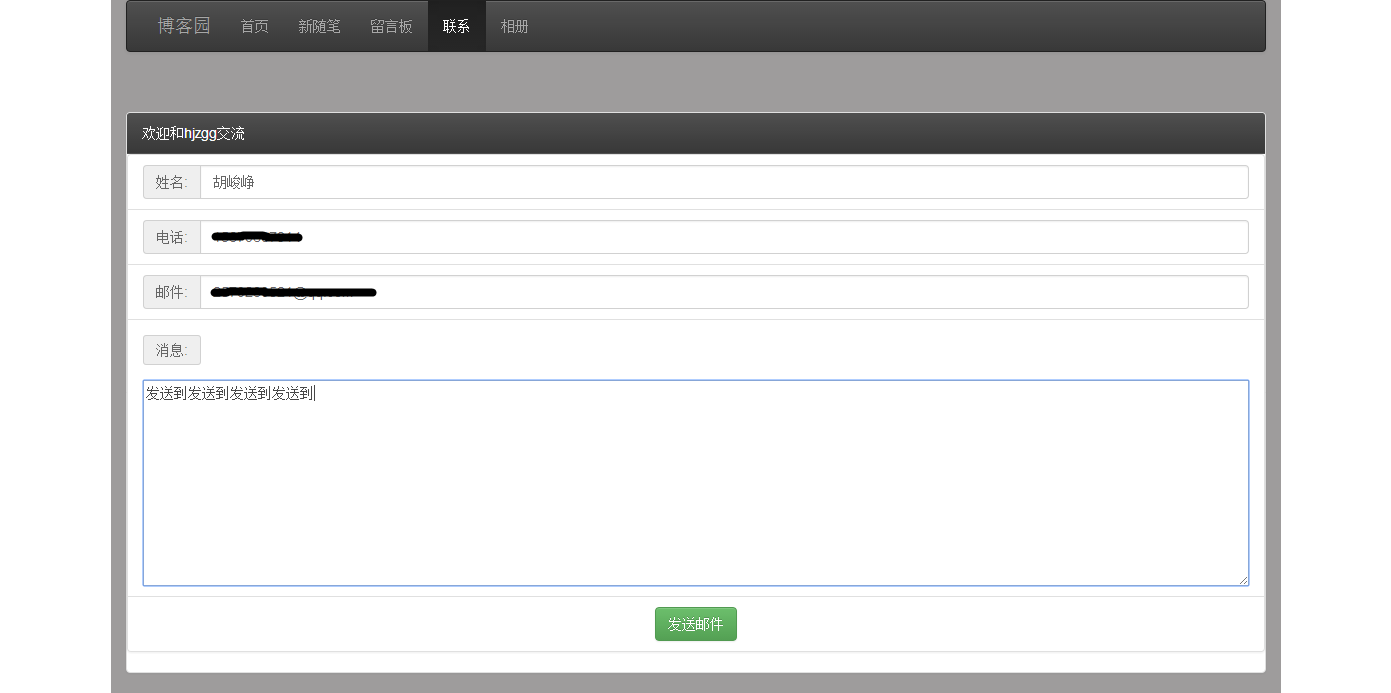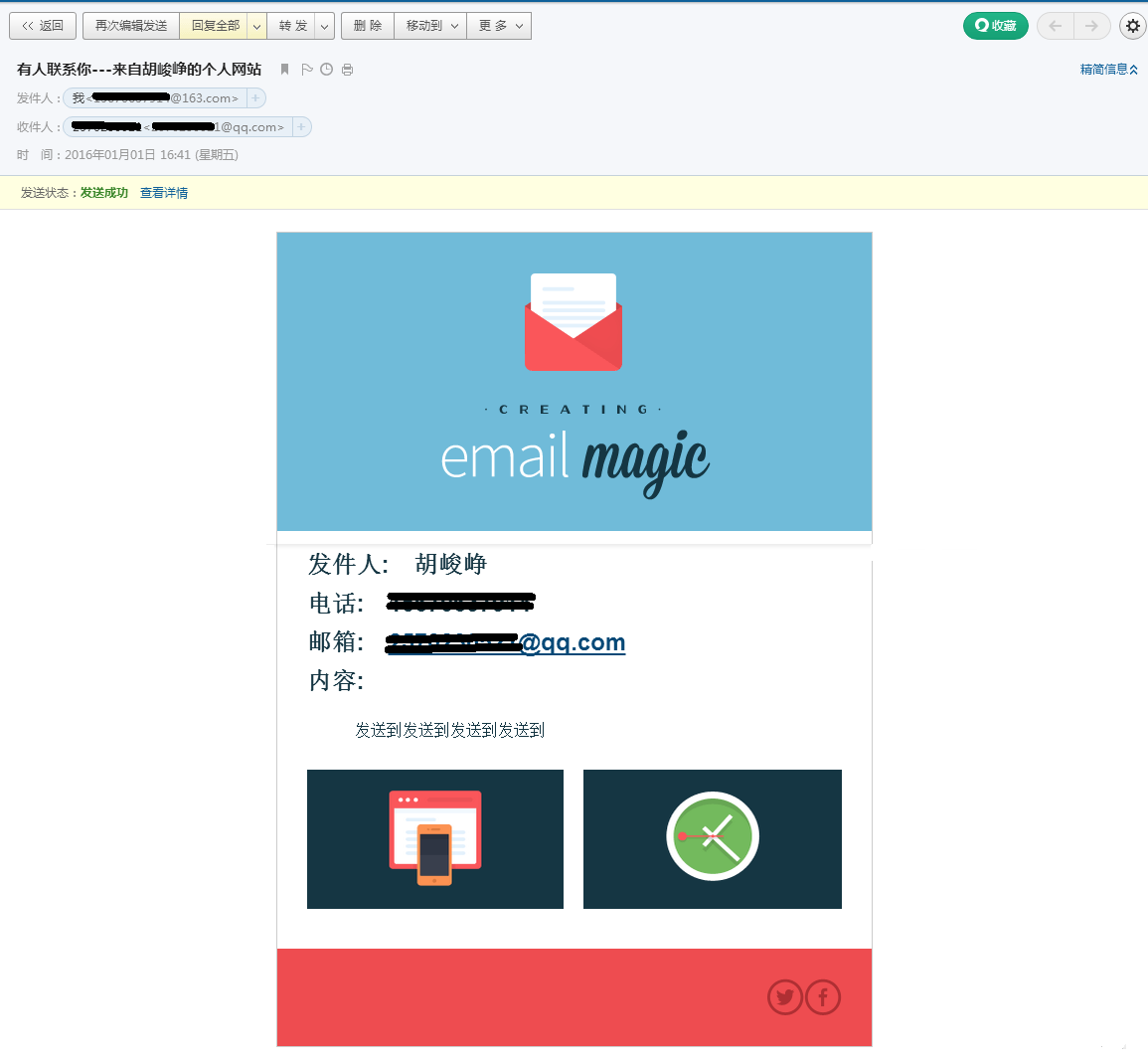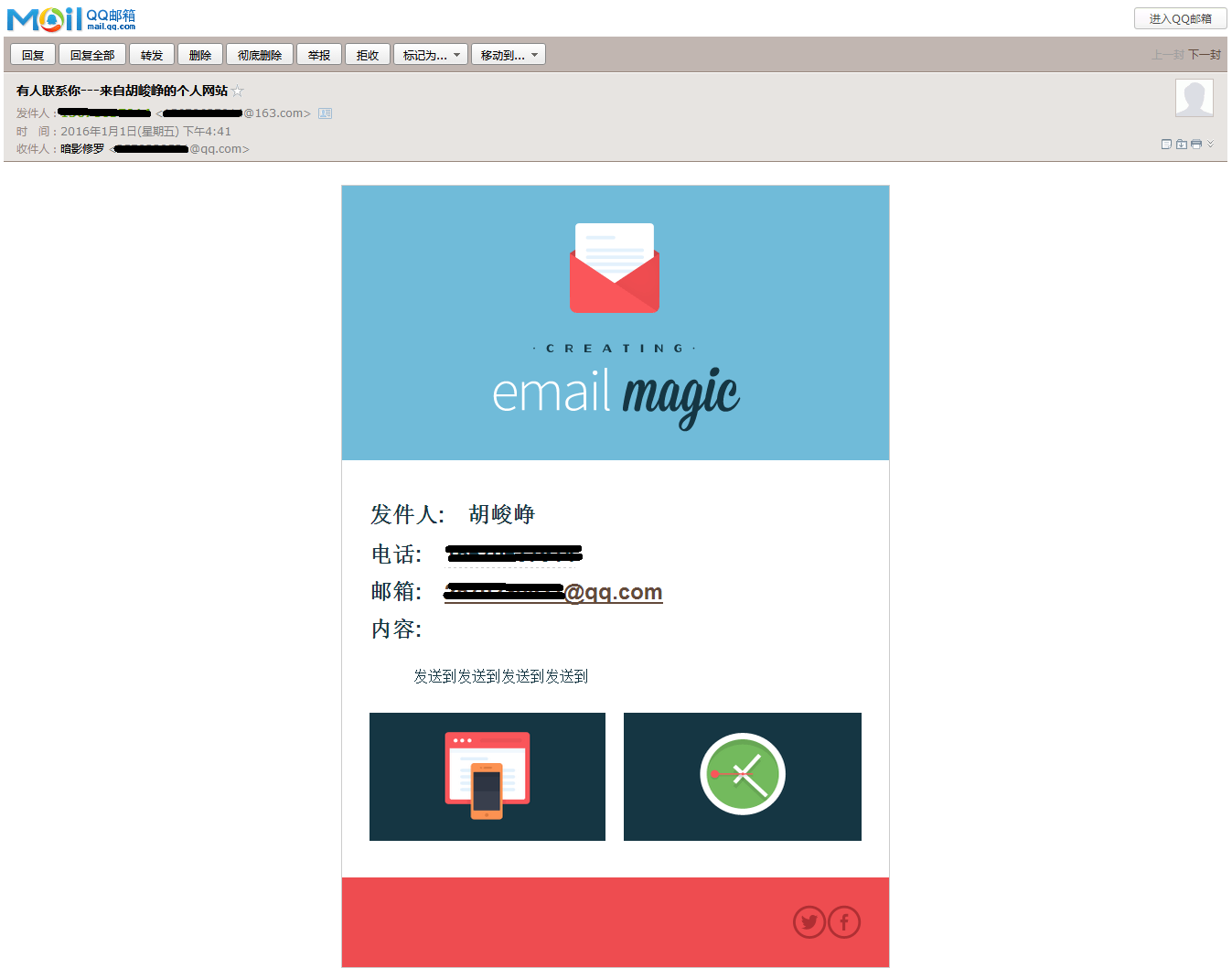java发送内嵌图片邮件
本文共 6182 字,大约阅读时间需要 20 分钟。
前言:
博客系统中需要邮件服务的功能,以前写过类似的功能,不过功能太简单了,仅仅是发送文本内容,现在尝试一下发送内嵌图片邮件!
准备工作:
请参考:
整体效果:
发送端:网易邮箱;接收端:qq邮箱。
1.web前端

2.在网易邮箱“已发送”中可以看见通过java代码发送的邮件

3.同样在qq邮箱中也可以看到这样的效果

实现过程:
1.web前端(bootstrap布局)
2.首先准备一个XML的模板(<xml-body>包含的是邮件的html格式的文本)。

发件人: {0} 电话: {1} 邮箱: {2} 内容: {3}




其中模板中会有一些标识符,如{i},表还是字符串的预留位置,然后通过MessageFormat格式化这样的消息,然后将格式化后的字符串插入到模式中的适当位置。
//得到XML的模板String XML_path = ServletActionContext.getServletContext().getRealPath("/mailTemplate")+"/myMailTemplete.xml"; String str=new ReaderXML().read(XML_path); Object[] obj=new Object[]{mailForm.getName(), mailForm.getPhone(), mailForm.getE_mail(), mailForm.getContent(), "e_mail", "left", "right", "tw", "fb"}; //MessageFormat可以格式化这样的消息,然后将格式化后的字符串插入到模式中的适当位置String tcontent = MessageFormat.format(str, obj); 最终XML模板中的{i}分别被obj[i]替换了。
3.写一个对XML模板的类ReaderXML
public class ReaderXML { public String read(String path){ String str=null; str=reader(path); return str; } private String reader(String path){ SAXReader reader=new SAXReader(); String str=null; try { Document d=reader.read(new File(path)); Element e=d.getRootElement(); Element htmle=e.element("html"); str=htmle.asXML(); } catch (DocumentException e) { e.printStackTrace(); } return str; }} 4.最后就是我们的控制器类MailAction
在 HTML 格式的正文中内含图片是使用MimeBodyPart类的setContentID() 方法设置对应的资源文件的唯一标识符,即 MIME 协议对于邮件的结构组织格式中的 Content-ID 头字段,对应着XML模板中的cid:{i}标识, 如<img src="cid:{8}"/>(注:{i}会通过MessageFormat.format替换成对应的字符串)
public class MailAction extends ActionSupport{ private MailForm mailForm; public MailForm getMailForm() { return mailForm; } public void setMailForm(MailForm mailForm) { this.mailForm = mailForm; } //添加内嵌图片 private MimeBodyPart createImageMimeBodyPart(String imageName) throws MessagingException, UnsupportedEncodingException{ FileDataSource fds=new FileDataSource(ServletActionContext.getServletContext().getRealPath("/image")+"/" + imageName + ".gif"); MimeBodyPart mbp=new MimeBodyPart(); DataHandler dh=new DataHandler(fds); mbp.setDataHandler(dh); //设置对应的资源文件的唯一标识符,即 MIME 协议对于邮件的结构组织格式中的 Content-ID 头字段; mbp.setHeader("Content-ID", imageName); mbp.setFileName(MimeUtility.encodeText(fds.getName())); return mbp; } public String sendMail(){ try { HttpServletRequest request = ServletActionContext.getRequest(); String pwd = "************";//发件人邮箱密码 String mailfrom = "***********@163.com"; //网易的邮箱 String wangyiFrom = mailfrom.substring(0, mailfrom.indexOf('@'));//网易邮箱的用户名 String tu = "163.com"; //发件人邮箱的后缀域名 String tto= "**********@qq.com"; //接收邮件的邮箱 String ttitle= "有人联系你---来自胡峻峥的个人网站"; //根据其物理路径,得到XML的模板 String XML_path = ServletActionContext.getServletContext().getRealPath("/mailTemplate")+"/myMailTemplete.xml"; String str=new ReaderXML().read(XML_path); Object[] obj=new Object[]{mailForm.getName(), mailForm.getPhone(), mailForm.getE_mail(), mailForm.getContent(), "e_mail", "left", "right", "tw", "fb"}; //MessageFormat可以格式化这样的消息,然后将格式化后的字符串插入到模式中的适当位置 String tcontent = MessageFormat.format(str, obj); Properties props=new Properties(); props.put("mail.smtp.host","smtp."+tu);//邮箱SMTP服务器地址端口 props.put("mail.smtp.auth","true");//这样才能通过验证 Session s=Session.getInstance(props); s.setDebug(true); MimeMessage message=new MimeMessage(s); //给消息对象设置发件人/收件人/主题/发信时间 InternetAddress from; from = new InternetAddress(mailfrom);//发件人的qq邮箱 message.setFrom(from); InternetAddress to=new InternetAddress(tto);//收件人的邮箱 message.setRecipient(Message.RecipientType.TO,to); message.setSubject(ttitle); message.setSentDate(new Date()); //给消息对象设置内容 BodyPart mbp=new MimeBodyPart();//新建一个存放信件内容的BodyPart对象 mbp.setContent(tcontent,"text/html;charset=gb2312");//给BodyPart对象设置内容和格式/编码方式 // 用于组合文本和图片,"related"型的MimeMultipart对象 Multipart mm=new MimeMultipart("related");//新建一个MimeMultipart对象用来存放BodyPart对象(事实上可以存放多个) mm.addBodyPart(mbp);//将BodyPart加入到MimeMultipart对象中(可以加入多个BodyPart) //添加图片 mm.addBodyPart(createImageMimeBodyPart("e_mail")); mm.addBodyPart(createImageMimeBodyPart("left")); mm.addBodyPart(createImageMimeBodyPart("right")); mm.addBodyPart(createImageMimeBodyPart("tw")); mm.addBodyPart(createImageMimeBodyPart("fb")); message.setContent(mm);//把mm作为消息对象的内容 message.saveChanges(); Transport transport=s.getTransport("smtp"); transport.connect("smtp."+tu, wangyiFrom, pwd); //这里的wangyiFrom为发件人网易账号 transport.sendMessage(message,message.getAllRecipients()); transport.close(); ActionContext.getContext().getSession().put("operations", "邮件发送成功, 请耐心等待回复!"); } catch (Exception e) { System.out.println(e.toString()); ActionContext.getContext().getSession().put("errors", e.toString()); return "errors"; } return "sendMail"; }} 最后附上前端图片:





参考Spring中邮件发送
转载地址:http://umnca.baihongyu.com/
你可能感兴趣的文章
Vue子传父,父组件事件处理函数中arguments的使用
查看>>
DispatchSemaphore & DispatchGroup
查看>>
使用Netty三分钟手写一个RPC
查看>>
前端导出数据表格(jpg、csv)
查看>>
少编码多思考:代码越多 问题越多
查看>>
反思一次羞愧的阿里面试经历
查看>>
Vue笔记——项目中设置mock数据
查看>>
# 【vue基础篇】一看就懂的vue环境变量配置
查看>>
你真的了解String吗?(修正版)
查看>>
## HTTP系列之Accept-Encoding和Content-Encoding
查看>>
深入理解redux源码
查看>>
适配器设计模式
查看>>
什么是翻译平台最重要的地方?
查看>>
web前端开发必学知识点 你都掌握了吗
查看>>
叽里呱啦G客沙龙,5月18日,上海
查看>>
基于Spring Cloud Gateway的路由实践
查看>>
程序猿生存指南-40 爱上野马
查看>>
智能小程序档案馆——搜索流量接入(一)
查看>>
Leetcode PHP题解--D19 867. Transpose Matrix
查看>>
第一章:nginx环境搭建
查看>>